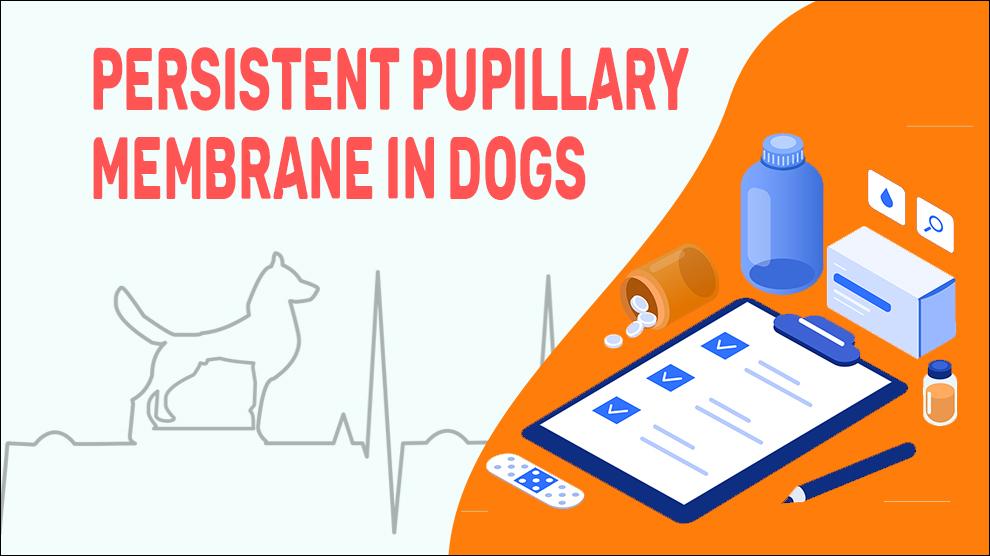Persistent Pupillary Membrane (PPM) is a congenital ocular disorder of the uveal tract that did not regress properly in the embryologic and postnatal stages.
PPMs are remnants of embryonic lenticular vasculature that once spanned the pupil to provide nutrients to the lens that is at the development stage. The resorption or regression is usually complete by weeks after birth but sometimes persists for several months in some dogs, so the name ‘persistent pupillary membrane’.
PPMs must be differentiated from eye synechiae with fibrinous adhesions that involve the pupillary margin. Sometimes, the remnants of PPMs may be identified on the axial anterior lens capsule as a set of fine, minute spots or depressions (punctate), brown to tan spots. The condition may be unilateral but is more commonly bilateral.
They can cause corneal opacification if they arc from the iris collarette to the corneal endothelium due to endothelial damage, fibrosis & traction.
Affected dogs are typically non-inflammatory and asymptomatic. Individual PPMs may be limited to the iris surface or may extend to the lens or cornea and at the attachment site, they cause non-progressive opacities.
Symptoms Of Persistent Pupillary Membrane
- Sleeping often / not being as playful as the rest of the litter / Visual impairment.
- Pigmented strands run from one side of the iris to the other side crossing the pupil space.
- Cloudy lines or foggy or corneal opacities.
- Seemingly confused or disoriented.
- Unusual Iris Movement
Treatment Options For Persistent Pupillary Membrane
No treatment is necessary until the PPMs are stable. When vision is getting impaired or the pupil is obstructed or any other secondary complications are observed, step-wise medical intervention is required.
Transection of iris-to-lens or iris-to-cornea PPMs.
Laser surgery may simultaneously rupture and photocoagulate PPM.
Penetrating keratoplasty in combination with the severing of PPMs May be indicated if vision is impaired by extensive corneal edema associated with iris-to-cornea PPMs.
Cataract extraction in combination with transection of PPM.
Home Remedies For Persistent Pupillary Membrane
When you first find out PPMs in your dogs, consult an optometrist or general ophthalmologist.
As most PPMs for affected dogs are incidental and benign, they do not require treatment or monitoring over time. The Prognosis is also excellent.
Prevention Of Persistent Pupillary Membrane
Dogs that have PPMs and their littermates must not be used for breeding. Preferably, all the genetically predisposed breeds (even those without clinical signs) should be carefully examined ophthalmically for PPM before being used in a breeding program. Breeders may use their discretion when PPM appears to be a one-off incident.
Additional Facts For Persistent Pupillary Membrane
- Causes:
- Congenital
- Trauma
- Tumors
- Age
- Types:
Variations of PPMs include:
- PPMs from iris to iris.
- Iris-to-lens.
- Iris to the corneal endothelium.
- In the front part of the eye, sheets of tissue extend between the iris, lens, and cornea.
- Morbidity:
- Usually, atrophy of the embryonic lenticular vasculature starts about 2 weeks before birth, with the pupillary membrane within 4-8 weeks after birth will be no longer present.
- Tiny pupillary membrane remnants are frequent in dogs and are usually disregarded.
- Membrane remnants may be seen as tissue strands originating from the collarette region or a minor arterial circle of the iris.
- The strands may extend across the pupil, from iris to iris, Iris-to-lens or to the cornea or to both, or there may be free-floating strands in the anterior chamber.
- Complications of PPMs include multiple ocular defects (such as cataracts, retinal dysplasia, microphthalmia, corneal opacification, dyscoria, etc).
- Mortality:
Congenital PPMs are from birth or present themselves from puppyhood. The mortality rate is almost zero.
- Diagnosis:
- Schirmer Tear Test (STT)
- Fluorescein Staining Test
- Tonometry
- Aesthesiometry
- Ultrasonography and electroretinography confirm that the retina and vitreous are healthy.
- Differential Diagnosis:
- Senile iris sphincter muscle atrophy.
- Iris Synechia
- Vitreous migration or Fibrin strands
- Other congenital abnormalities of the anterior uvea.
- Prognosis:
There is no proper treatment and in the majority of cases, quality of life is not affected. But if there are associated complications like cataracts, the outcome depends on the size and severity of the condition. In general, PPMs have an excellent prognosis. There are no racial and sex-related differences affecting the prognosis.
When To See A Vet
Contact your vet right away, if you notice any of the following:
- Signs of visual impairment.
- Pigmented strands run from one side of the iris to the other side crossing the pupil space.
- Cloudy lines or foggy or corneal opacities.
Food Suggestions For Persistent Pupillary Membrane
- Whole, unprocessed, or minimally foods (meats, seafood, grains, legumes, nuts, etc).
- Low-carb dog food (sweet potatoes, peas, yams, squash, pumpkin).
- Lean meat protein
- Shrimp, Salmon, Tuna, Cod, Halibut, Trout, Herring fish
- Blueberries, Kale, Broccoli, Carrots
- Oysters and Pork
- Leafy green vegetables (Lettuce, Spinach, Salad Greens, Parsley, Collard Greens).
Conclusion
The possibility of a loss of vision for your dog cannot be ruled out, however, that is very rare. The prognosis of the eye preserving good vision will not be impaired in most cases. Dogs that have vision problems due to PPMs may simply have to make some adjustments in their lifestyle.
Though it may not go away, your dog’s quality of life cannot be impaired by this condition.

















